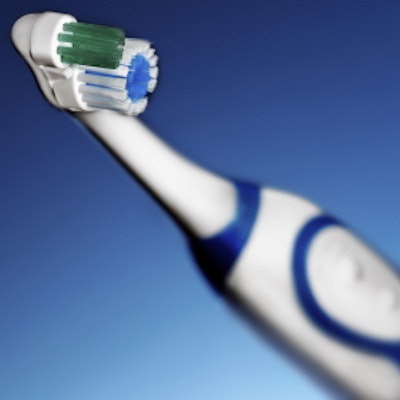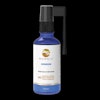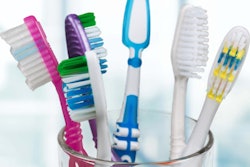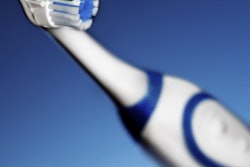
Power toothbrushes are popular and have been shown to reduce gingivitis and plaque better than manual toothbrushes, but could their long-term use increase dentin loss?
An international team of researchers examined this issue by conducting an in vitro study that simulated long-term use of an abrasive whitening toothpaste with four types of toothbrushes: a rotating-oscillating power toothbrush, a side-to-side sonic power toothbrush, and two manual ones. They found that the amount of dentin abrasion was greatest with the power toothbrushes.
"Using the same brushing force and a highly abrasive toothpaste, manual toothbrushes are significantly less abrasive compared to power toothbrushes for an 8.5-year simulation," wrote the study authors, led by Mozhgan Bizhang, Dr med dent, from Witten/Herdecke University in Witten, Germany (PLOS One, February 21, 2017).
The study was conducted by Dr. Bizhang and her colleagues from Witten/Herdecke University and the University of Texas Health Science Center at San Antonio.
It's all in the brush
As the population in many developed countries is aging and retaining their teeth, the number of exposed root surfaces and noncarious cervical lesions among the elderly is increasing, according to the authors.
The mechanical interaction among toothbrush, toothpaste, and tooth can cause substance loss that leads to the development of these noncarious lesions. While frictional forces are increased by small particles in toothpaste, abrasivity can be modified by the type of toothbrush and the brushing force applied, they noted.
The researchers wanted to find out if the long-term use of a power toothbrush in combination with an abrasive whitening toothpaste could harm hard tissues. Therefore, they simulated dentin abrasion over the long term using four different toothbrushes along with highly abrasive toothpaste with a relative dentin abrasiveness index of 150 (Dentalux, Dental-Kosmetik, Dresden, Germany).
They used the following toothbrushes:
- Sonic toothbrush (Sonicare PowerUp, Philips, Hamburg, Germany)
- Oscillating-rotating toothbrush (Oral B Vitality Precision Clean, Procter & Gamble, Schwalbach am Taunus, Germany)
- Manual toothbrush with flat trim brush head (Dr. Best Original, Glaxo-Smith-Kline, Bühl, Germany)
- Manual toothbrush with rippled-shaped brush head (Blend-a-Dent Complete V-Interdental, Blend-a med, Procter & Gamble, Schwalbach am Taunus, Germany)
The researchers obtained dentin samples from 72 extracted human molars, assigning 18 teeth to each toothbrush. They prepared one specimen from each tooth by removing the enamel layer until the dentin layer was exposed and polishing the dentin surface. Half of each surface was then covered with an adhesive tape.
“Using the same brushing force and a highly abrasive toothpaste, manual toothbrushes are significantly less abrasive compared to power toothbrushes for an 8.5-year simulation.”
The researchers used a toothbrushing machine developed to simulate teeth cleaning by power and manual toothbrushes. Each toothbrush cleaned up to three dentin samples using a linear cleaning movement of 3 cm and a moderate brushing force of 2 N. A slurry was made by mixing the toothpaste with water at a ratio of 1:3.
Each sample was brushed for 260 minutes, which was calculated to be equivalent to 8.5 years of brushing based on a brushing time of 120 seconds twice a day for all teeth. Because of the different brushing movements of power and manual toothbrushes, each sample underwent either 2,600 brushing strokes at a rate of 10 strokes per minute with a power toothbrush or 31,200 brushing strokes at a rate of 120 strokes per minute with a manual toothbrush.
The bristles for the sonic toothbrush move side to side, according to the device's manual, while the head for the oscillating-rotating one moves from a center point but does not rotate in a full circle, the authors noted.
After removing the adhesive tape, the researchers evaluated the differences in surface abrasion between the exposed and protected areas of the dentin specimens.
The amount of dentin abrasion was significantly different among all the toothbrushes:
- 21.03 µm with the sonic toothbrush
- 15.71 µm with the oscillating-rotating toothbrush
- 6.13 µm with the flat trim manual toothbrush
- 2.50 µm with the rippled-shaped manual toothbrush
The results showed that a high stroke frequency with manual toothbrushes was less abrasive than the low stroke frequency of the power toothbrushes, according to the authors. The bristles of the sonic toothbrush traveled a longer distance compared with the oscillating-rotating toothbrush or the manual ones, which may have contributed to the greater dentin loss, they explained.
Between the power toothbrushes, the sonic toothbrush produced more abrasions compared with the oscillating-rotating toothbrush, whereas the rippled-shaped manual toothbrush produced less abrasion than the flat trim brush. The flat-form manual toothbrush had more filaments contacting the dentin surfaces than the rippled-shaped manual brush, whereas the sonic power toothbrush may apply shear forces to the dentin surface when longer bristles execute wiping movements on activation, according to the authors.
"Our study shows that abrasion of dentin by tooth brushing depends to a significant degree on the type of toothbrush," they wrote.
Toothpaste matters, too
The study authors noted that toothbrushes independently don't cause significant differences in dentin abrasion, as one study found that brushing without toothpaste resulted in minimal abrasion, but another found that increasing toothpaste abrasivity led to more surface loss of enamel samples.
"This long-term in vitro study showed that the formation of dentin abrasions depends on the brushing mode and bristle arrangement for manual and power toothbrushes used with a toothpaste with high abrasivity," they concluded.



















